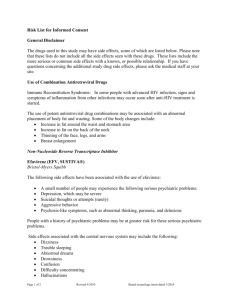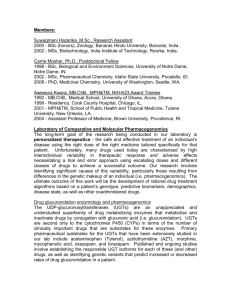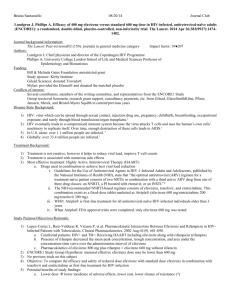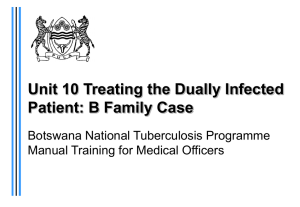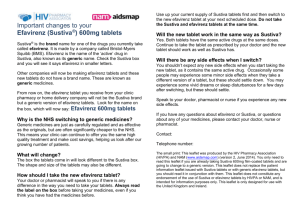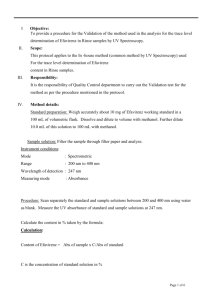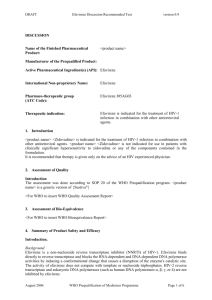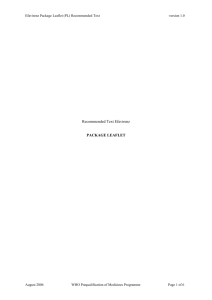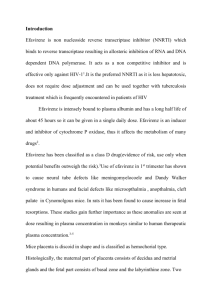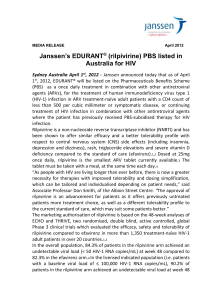SPC-efavirenz
advertisement
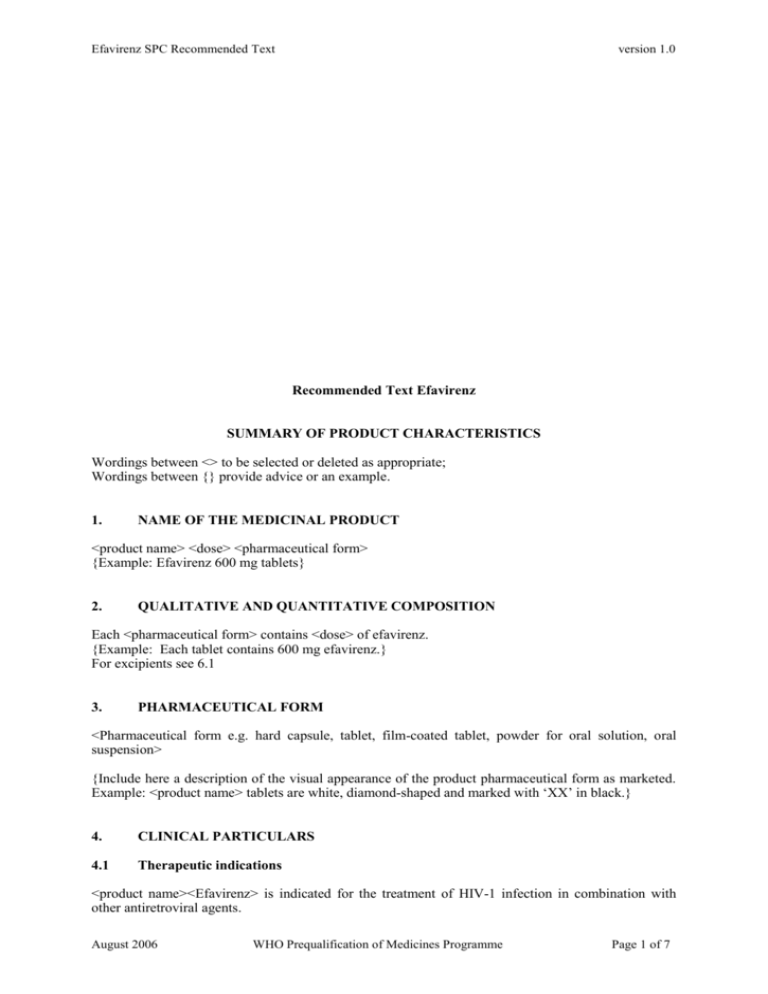
Efavirenz SPC Recommended Text
version 1.0
Recommended Text Efavirenz
SUMMARY OF PRODUCT CHARACTERISTICS
Wordings between <> to be selected or deleted as appropriate;
Wordings between {} provide advice or an example.
1.
NAME OF THE MEDICINAL PRODUCT
<product name> <dose> <pharmaceutical form>
{Example: Efavirenz 600 mg tablets}
2.
QUALITATIVE AND QUANTITATIVE COMPOSITION
Each <pharmaceutical form> contains <dose> of efavirenz.
{Example: Each tablet contains 600 mg efavirenz.}
For excipients see 6.1
3.
PHARMACEUTICAL FORM
<Pharmaceutical form e.g. hard capsule, tablet, film-coated tablet, powder for oral solution, oral
suspension>
{Include here a description of the visual appearance of the product pharmaceutical form as marketed.
Example: <product name> tablets are white, diamond-shaped and marked with ‘XX’ in black.}
4.
CLINICAL PARTICULARS
4.1
Therapeutic indications
<product name><Efavirenz> is indicated for the treatment of HIV-1 infection in combination with
other antiretroviral agents.
August 2006
WHO Prequalification of Medicines Programme
Page 1 of 7
Efavirenz SPC Recommended Text
4.2
version 1.0
Posology and method of administration
Oral use.
Therapy should be prescribed by a physician experienced in the management of HIV-1 infection.
Adults and adolescents over 40 kg: the recommended dosage of efavirenz is 600 mg orally, once
daily.
<<product name><pharmaceutical form> are not suitable for adolescents < 40 kg or children.>
<Adolescents and children (3 to 17 years): the recommended dose of efavirenz for patients between
3 and 17 years of age is described in the table.>
<Table: Paediatric dose to be administered once daily
Body Weight (kg)
13 to < 15
15 to < 20
20 to < 25
25 to < 32.5
32.5 to < 40
40
Efavirenz dose (mg)
200
250
300
350
400
600
>
Efavirenz should be taken on an empty stomach or with a low-fat meal.
Liver Disease
No dose adjustment is necessary for mild to moderate liver impairment, but discontinuation may be
necessary for severe liver impairment.
Renal Impairment
No dose modification (1, 2) is necessary.
4.3
Contraindications
<product name><Efavirenz> is contraindicated in patients with clinically significant hypersensitivity
to efavirenz or to any of the components contained in the formulation.
4.4
Special warnings and special precautions for use
<product name><Efavirenz> should not be used as part of a triple combination regimen consisting of
efavirenz, didanosine and tenofovir because of inferior efficacy compared to other combination
regimens (3-5).
Rash
A mild-to-moderate rash commonly (15-30%) develops within two weeks after starting efavirenz and
does not require discontinuation. The rash usually resolves within two weeks. Severe rash (1-2%) or
erythema / Steven-Johnson syndrome (< 0.1%) requires immediate discontinuation. Patients who
discontinued treatment with other NNRTIs due to rash may be at higher risk of developing rash during
treatment with efavirenz.
Central nervous system
Central nervous system side effects are very common (~50%) after starting efavirenz (6). These
symptoms typically occur within the first week of treatment and usually resolve within 4 weeks of
treatment (7). Symptoms including confusion, dizziness, insomnia, somnolence, impaired
concentration and abnormal dreaming. Other side effects include amnesia, hallucinations, euphoria
and psychosis. There is a potential additive effect with alcohol and other psychoactive drugs.
August 2006
WHO Prequalification of Medicines Programme
Page 2 of 7
Efavirenz SPC Recommended Text
version 1.0
Liver toxicity
Increased transaminase levels may occur months after starting efavirenz and may be more frequent in
those with HCV-co-infection (8, 9). Discontinuation is recommended if hepatoxicity is symptomatic
(infrequent), caused by hypersensitivity or if the transaminase levels are > 10 times the upper limit of
normal.
4.5
Interaction with other medicinal products and other forms of interaction
Efavirenz is an inducer of the hepatic enzyme CYP3A4 and an inhibitor of some CYP isozymes
including CYP4A; therefore, it is possible that co-administration of efavirenz with medicinal products
(for example astemizole, terfenadine, cisapride, midazolam, triazolam, ergot derivatives and St. John’s
wort) or food (for example grapefruit juice) which affect CYP3A4 activity may result in an alteration
in the plasma concentration of either agent.
Efavirenz decreases plasma concentrations of methadone(10). Methadone-maintained patients
beginning efavirenz therapy should be assessed for evidence of withdrawal and methadone dose
should be adjusted accordingly.
Rifampicin may significantly decrease levels of efavirenz (11). Rifampin levels are unaffected.
Efavirenz decreases serum levels of atorvastatin, pravastatin and simvastatin (12).
Efavirenz decreases serum levels of clarithromycin; the risk of rash is significantly increased.
Efavirenz increases levels of ethinyl estradiol. Barrier contraception should always be used in
combination with other contraceptive methods.
Efavirenz significantly decreases levels of amprenavir, atazanavir, indinavir, lopinavir, and saquinavir
but increases levels of nelfinavir and ritonavir. Therefore, if efavirenz is given with either of these
drugs, dosage adjustments of either may be necessary or alternatively ritonavir boosting may be
necessary. Efavirenz does not alter the levels of fos-amprenavir or tipranavir. Ritonavir significantly
increases levels of efavirenz.
4.6
Pregnancy and lactation
Pregnancy: Efavirenz is assigned FDA Pregnancy Category D status, i.e. positive evidence of risk (
www.apregistry.com ). Cases of neureal tube defects in infants born to women with first trimester
exposure have been reported. Thus, efavirenz is contraindicated in women willing to become pregnant
or in case of a positive pregnancy test.
4.7
Effects on ability to drive and use machines
Efavirenz may cause central nervous system side effects such as dizziness, impaired concentration,
and/or somnolence. Patients should be instructed that if they experience these symptoms they should
avoid potentially hazardous tasks such as driving or operating machinery.
4.8
Undesirable effects
The following adverse events have been reported in controlled clinical trials and case series during
treatment of HIV-1 infection with efavirenz.
The adverse events considered at least possibly related to the treatment are listed below by body
system, organ class and absolute frequency. Frequencies are defined as very common (>1/10),
common (>1/100, <1/10), uncommon (>1/1000, <1/100), rare (>1/10,000, <1/1000), very rare
(<1/10,000).
Metabolic and nutrition disorders:
August 2006
WHO Prequalification of Medicines Programme
Page 3 of 7
Efavirenz SPC Recommended Text
version 1.0
Very common: Increases in fasting triglycerides, total cholesterol, high- and low-density lipoprotein
cholesterol (13, 14).
Common: Gynaecomastia (15).
Nervous system disorders
Very common: confusion, dizziness, insomnia, somnolence, impaired concentration and abnormal
dreaming (6, 7).
Common: Anxiety and depression (16) .
Uncommon: Psychosis (increased likelihood in those with history of psychiatric disease).
Hepatobiliary disorders
Common: Elevation of liver enzymes (8, 9).
Skin and subcutaneous tissue disorders
Very common: Rash (6, 16, 17).
4.9
Overdose
Some patients accidentally taking 600 mg twice daily have reported increased nervous system
symptoms. One patient experienced involuntary muscle contractions. Treatment of overdose with
efavirenz should consist of general supportive measures, including monitoring of vital signs and
observation of the patient’s clinical status. Administration of activated charcoal may be used to aid
removal of unabsorbed efavirenz. There is no specific antidote for overdose with efavirenz. Since
efavirenz is highly protein bound, dialysis is unlikely to remove significant quantities of it from blood.
5.
PHARMACOLOGICAL PROPERTIES
5.1
Pharmacodynamic properties
Pharmacotherapeutic group: <group>, ATC Code <code>
{Example: Antiretroviral, ATC code: J05AG03}
Efavirenz is a non-nucleoside reverse transcriptase inhibitor (NNRTI) of HIV-1. Efavirenz binds
directly to reverse transcriptase and blocks the RNA-dependent and DNA-dependent DNA polymerase
activities by inducing a conformational change that causes a disruption of the enzyme's catalytic site.
The activity of efavirenz does not compete with template or nucleoside triphosphates. HIV-2 reverse
transcriptase and eukaryotic DNA polymerases (such as human DNA polymerases α, β, γ, or δ) are not
inhibited by efavirenz.
Clinical efficacy
Efavirenz has been investigated in several randomized, prospective clinical trials combined with other
antiretroviral drugs (6, 16, 18-27). These studies have demonstrated significant decreases in plasma
HIV RNA and increases in CD4 cell counts when used in combination with nucleoside analogue(s)
and/or a PI. In recent studies by intention-to-treat analysis > 70% of subjects have achieved plasma
HIV RNA < 50 copies/ml after 48 weeks of combination treatment that included efavirenz with other
antiretroviral drugs (18, 27).
HIV-1 resistance to efavirenz involves the development of mutations in the reverse transcriptase gene
at positions 100, 103, 106, 108, 181, 188 and 190 ( www.iasusa.org ). The K103N or Y188L mutation
alone prevents the clinical utility of efavirenz. The V106M mutation is more common in HIV-1
subtype C than subtype B.
Rapid emergence of resistance to NNRTIs, including efavirenz, is likely to occur in case of virological
failure.
August 2006
WHO Prequalification of Medicines Programme
Page 4 of 7
Efavirenz SPC Recommended Text
version 1.0
Patients who are infected with known efavirenz-resistant HIV or patients who have previously
experienced virological failure on an efavirenz- or nevirapine-containing regimen may not respond
sufficiently to further treatment with a combination regimen containing efavirenz or nevirapine.
5.2
Pharmacokinetic properties
Absorption and Bioavailability
Bioavailability is 40% to 45% without food. Fat-containing meals increase absorption significantly.
Peak efavirenz plasma concentrations of 1.6 - 9.1 µM were attained by 5 hours following single oral
doses of 100 mg to 1,600 mg administered to uninfected volunteers. Dose related increases in Cmax and
AUC were seen for doses up to 1,600 mg; the increases were less than proportional suggesting
diminished absorption at higher doses. Time to peak plasma concentrations (3 - 5 hours) did not
change following multiple dosing and steady-state plasma concentrations were reached in 6 - 7 days.
In HIV infected patients at steady state, mean C max, mean Cmin, and mean AUC were linear with 200
mg, 400 mg, and 600 mg daily doses. In 35 patients receiving efavirenz 600 mg once daily, steady
state Cmax was 12.9 ± 3.7 µM (29%) mean ± S.D. (% C.V.), steady state Cmin was 5.6 ± 3.2 µM (57%),
and AUC was 184 ± 73 µM·h (40%).
Distribution
Efavirenz is highly bound (approximately 99.5 - 99.75%) to human plasma proteins, predominantly
albumin. In HIV-1 infected patients (n = 9) who received efavirenz 200 to 600 mg once daily for at
least one month, cerebrospinal fluid concentrations ranged from 0.26 to 1.19% (mean 0.69%) of the
corresponding plasma concentration. This proportion is approximately 3-fold higher than the nonprotein-bound (free) fraction of efavirenz in plasma.
Metabolism / Elimination
Efavirenz is principally metabolised by the cytochrome P450 system to hydroxylated metabolites with
subsequent glucuronidation of these hydroxylated metabolites. These metabolites are essentially
inactive against HIV-1. The in vitro studies suggest that CYP3A4 and CYP2B6 are the major
isozymes responsible for efavirenz metabolism and that it inhibited P450 isozymes 2C9, 2C19, and
3A4. In in vitro studies efavirenz did not inhibit CYP2E1 and inhibited CYP2D6 and CYP1A2 only at
concentrations well above those achieved clinically. Efavirenz has been shown to induce P450
enzymes, resulting in the induction of its own metabolism. In uninfected volunteers, multiple doses of
200 - 400 mg per day for 10 days resulted in a lower than predicted extent of accumulation (22 - 42%
lower) and a shorter terminal half-life of 40 - 55 hours (single dose half-life 52 - 76 hours).
Efavirenz has a relatively long terminal half-life of 52 to 76 hours after single doses and 40 - 55 hours
after multiple doses. Approximately 14 - 34% of a radio-labelled dose of efavirenz was recovered in
the urine and less than 1% of the dose was excreted in urine as unchanged efavirenz.
5.3
Preclinical safety data
Preclinical data revealed no special hazard for humans other than those observed in clinical studies
based on conventional studies of safety, pharmacology, repeated dose toxicity, and genotoxicity.
In reproductive toxicology studies, malformations were observed in 3 of 20 foetuses/newborns from
efavirenz-treated cynomolgus monkeys given doses resulting in plasma efavirenz concentrations
similar to those seen in humans. Carcinogenicity studies showed an increased incidence of hepatic and
pulmonary tumours in female mice, but not in male mice.
6.
PHARMACEUTICAL PARTICULARS
6.1
List of excipients
[Product specific]
6.2
Incompatibilities
<Not applicable.>
August 2006
WHO Prequalification of Medicines Programme
Page 5 of 7
Efavirenz SPC Recommended Text
6.3
version 1.0
Shelf life
[Product specific]
6.4
Special precautions for storage
[Product specific]
6.5
Nature and contents of container
[Product specific]
6.6
Instructions for use and handling and disposal
<No special requirements.>
7.
<PREQUALIFICATION><MARKETING AUTHORISATION> HOLDER
[Product specific]
8.
<PREQUALIFICATION><MARKETING AUTHORISATION> NUMBER(S)
[Product specific]
9.
DATE OF FIRST <PREQUALIFICATION><AUTHORISATION> / RENEWAL OF
THE <PREQUALIFICATION><AUTHORISATION>
[Product specific]
10. DATE OF REVISION OF THE TEXT
{month year}
August 2006
WHO Prequalification of Medicines Programme
Page 6 of 7
Efavirenz SPC Recommended Text
version 1.0
Reference List
1.
2.
3.
4.
5.
6.
7.
8.
9.
10.
11.
12.
13.
14.
15.
16.
17.
18.
19.
20.
21.
22.
23.
24.
25.
26.
27.
H. Izzedine, G. Aymard, V. Launay-Vacher, A. Hamani, G. Deray, AIDS 14, 618 (2000).
M. John Gill, N. J. Ostrop, W. D. Fiske, J. M. Brennan, AIDS 14, 1062 (2000).
D. Podzamczer et al., Antivir. Ther. 10, 171 (2005).
C. Torti et al., Antivir. Ther. 10, 505 (2005).
D. Maitland et al., AIDS 19, 1183 (2005).
S. Staszewski et al., N. Engl. J. Med. 341, 1865 (1999).
D. B. Clifford et al., Ann. Intern. Med. 143, 714 (2005).
M. S. Sulkowski, D. L. Thomas, S. H. Mehta, R. E. Chaisson, R. D. Moore, Hepatology 35,
182 (2002).
L. Martin-Carbonero, M. Nunez, J. Gonzalez-Lahoz, V. Soriano, HIV. Clin. Trials 4, 115
(2003).
S. M. Clarke et al., Br. J. Clin. Pharmacol. 51, 213 (2001).
L. F. Lopez-Cortes et al., Clin. Pharmacokinet. 41, 681 (2002).
J. G. Gerber et al., J. Acquir. Immune. Defic. Syndr. 39, 307 (2005).
M. Nunez et al., HIV. Clin. Trials 3, 186 (2002).
L. F. van et al., PLoS. Med. 1, e19 (2004).
J. A. Mira et al., Antivir. Ther. 9, 511 (2004).
F. van Leth et al., Lancet 363, 1253 (2004).
J. Ananworanich et al., AIDS 19, 185 (2005).
G. K. Robbins et al., N. Engl. J. Med. 349, 2293 (2003).
R. W. Shafer et al., N. Engl. J. Med. 349, 2304 (2003).
K. Squires et al., J. Acquir. Immune. Defic. Syndr. 36, 1011 (2004).
R. M. Gulick et al., N. Engl. J. Med. 350, 1850 (2004).
M. S. Saag et al., JAMA 292, 180 (2004).
J. E. Gallant et al., JAMA 292, 191 (2004).
E. DeJesus et al., Clin. Infect. Dis. 39, 1038 (2004).
E. DeJesus et al., Clin. Infect. Dis. 39, 411 (2004).
G. J. Moyle et al., J. Acquir. Immune. Defic. Syndr. 38, 417 (2005).
J. E. Gallant et al., N. Engl. J. Med. 354, 251 (2006).
August 2006
WHO Prequalification of Medicines Programme
Page 7 of 7
